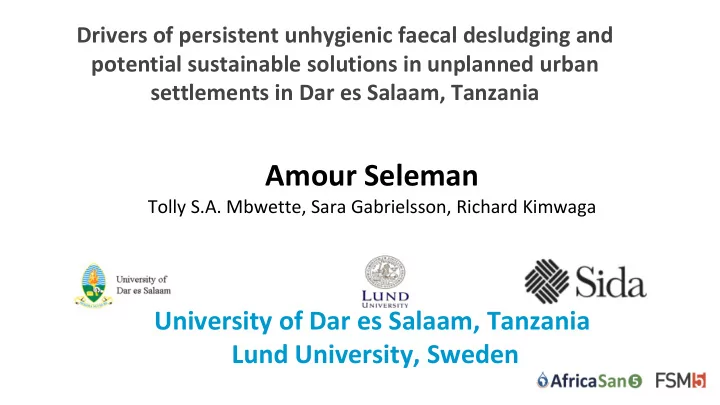

Drivers of persistent unhygienic faecal desludging and potential sustainable solutions in unplanned urban settlements in Dar es Salaam, Tanzania Amour Seleman Tolly S.A. Mbwette, Sara Gabrielsson, Richard Kimwaga University of Dar es Salaam, Tanzania Lund University, Sweden
Pit latrines in high water table congested settlements
Background • There is evidence that in areas constrained with space, the challenge of filing onsite sanitation is to be addressed through desludging • Mechanized and human powered equipment have been invented for hygienic desludging (GOAL, 2016) • Unhygienic desludging persist
Purpose of the study This study explored current situation on the ground and factors contributing to the persistence of unhygienic desludging in unplanned settlements in Dar es Salaam
Material and Methods • Cross section study • Mixed methods • Data were collected from 395 dwelling houses using Epicollect5 app • Tests of association were performed in SPSS Ver.25. • Odds ratio calculated using Binary logistic regression model - 𝑀𝑝𝑗𝑢 π = α + β𝑌 + ɛ
Results: Types of toilets and condition Connected to sewer 0,3 Septic tank 13,4 22% are full Pour Flush 23,3 VIP Latrine 8,1 34% unlined Improved Traditional Latrine 41,5 Ecosan 0,8 Traditional latrine 12,4 The water table is high No toilet 0,3 0,0 10,0 20,0 30,0 40,0 50,0
Results:…Desludging equipment and practices HYGIENIC DESLUDGING UNHYGIENIC DESLUDGING 75% 24% 1% 0%
Drivers of unhygienic desludging: Results of Logistic regression model Parameter Exp. (B) Sig. Low lying areas 1.677 0.400 Location Lack of space for parking 4.828 0.002* Toilet design Unimproved toilets 2.23 0.505 and condition Dry pits 1.026 0.871 Direct to pit toilets 1.034 0.958 Unlined pits 1.717 0.403
Drivers of unhygienic desludging: Results of Logistic regression mode l … Parameter Exp.(B) Sig. Low rent per Month 1.262 0.672 Socio-economic Few families (≤3) in a 1.856 0.252 status dwelling house Collect water from 1.432 0.783 public collection point
Conclusion and Recommendations Unhygienic desludging still a common practice The practice is common among the poor, those in low lying areas and HH with toilets that lack lining Weak stakeholders collaboration with regard to manual operated equipment despite ineffectiveness of the Gulper
Conclusion and Recommendations… • Improvement in desludging services should insist on lining of pits • Consideration should be given to the poor who can not afford pit lining e.g. loan schemes • The effectiveness of sanitation solutions that do not require deep pits such as simplified sewers, BFL toilets need to be investigated
Summary Residents in unplanned settlements are likely to be left behind if desludging challenges are not addressed • Pit lining along with a space for desludging may improve faecal desludging • Shallow pit sanitation systems in water logged areas • Feasibility of non pit based toilets in water logged areas need to be researched further
Points to remember Hygienic desludging still a challenge in unplanned settlements Poor toilet design and high water table traps hygienic desludging in DSM
Recommend
More recommend